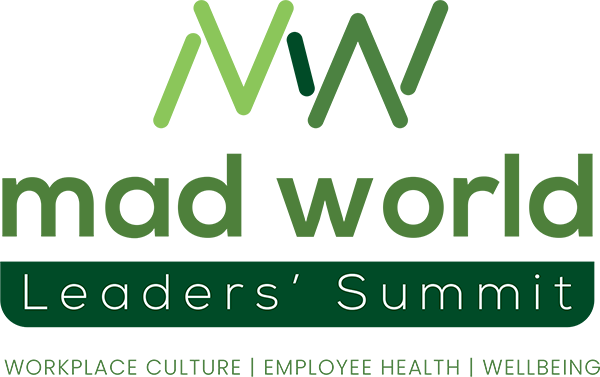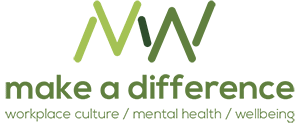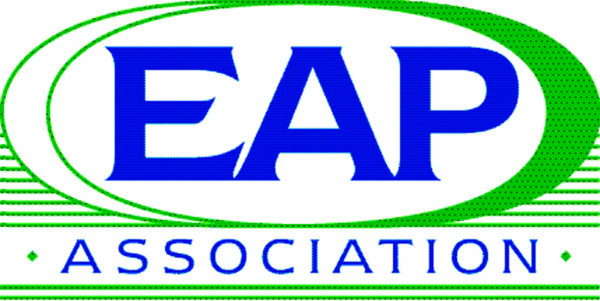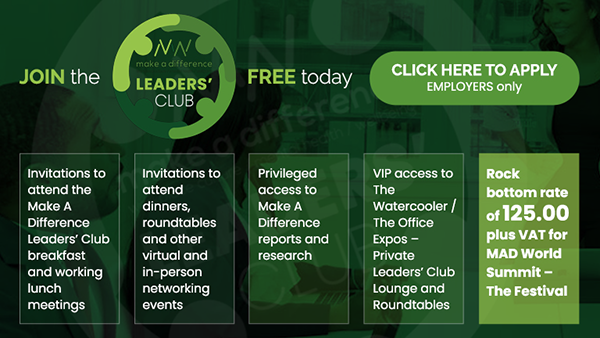2025 Speakers

Dame Carol Black GBE

Dr Monika Misra


Marc Molloy


Paula Stannett


Dr Richard Peters

Dr Shriti Pattani OBE


Tom Kegode

Chloe Muir
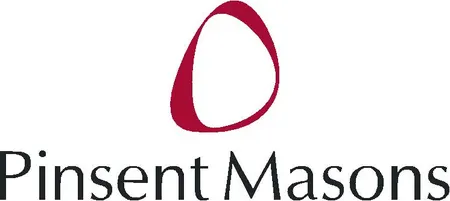

Charles Alberts


Gethin Nadin


Dr Lia Ali

Arti Kashyap-Aynsley
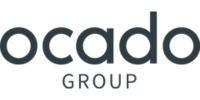
The 8th Annual MAD World Summit
Rethinking work, reimagining engagement, reinforcing health & wellbeing
Since launching in 2018, the MAD World Summit has been at the forefront of redefining employee health and wellbeing. In 2025, we’re going even further. This year, MAD World brings together four powerful tracks in one transformative day — built to break silos, spark cross-functional collaboration, and align workplace culture, employee health and wellbeing with business strategy.
As organisations adapt to ongoing change — from economic pressure to shifting employee expectations — the focus is no longer just on why health and wellbeing matters, but on how to make it work as a strategic lever for engagement, growth and performance. Senior leaders across functions are now asking:
- How do we move from fragmented efforts to integrated strategy?
- How do we focus on delivering measurable outcomes and ROI?
- How do we design work to support people — and enable performance?
“From strategic insights to practical takeaways, sessions are carefully curated to help you navigate uncertainty in an increasingly volatile world, support your people more effectively, and unlock their full potential—now and into the future”.
Claire Farrow, Global Head of Content, Make A Difference
Topics we’ll be addressing include:
- Debate: Employee health and wellbeing – strategic imperative, moral mandate or both?
- Keeping Britain working: The employer’s role in shaping a resilient economy through prevention, retention, early intervention and rapid rehabilitation
- Power in Alignment: How CHROs, CFOs and CIOs are collaborating to make health and wellbeing a business driver
- Leading through change: Supporting employees’ health and wellbeing through uncertain times
- Future-proofing health benefits: Focusing on prevention to manage rising costs without compromising care
- Navigating AI Disruption: Protecting employee health and culture in a tech-driven future
- Emerging health risks and how employers can prepare to maintain business resilience
- EAPs in a VUCA world – are they fit for purpose?
- Unpacking Psychosocial Risk: What’s driving it – and what employers must change
- DE&I in the new world order: Building workplaces that support everyone’s health and potential
- Future-proofing talent: Integrating health, wellbeing and skills development in a multi-generational workforce
- From Insight to Action: How the legal sector can lead with a data-driven approach to supporting mental health, wellbeing and culture
- Miscarriage to menopause: are workplaces failing women?
- The strategic advantage of a financially fit workforce
And more.
The MAD World Summit will bring together senior decision-makers from HR, Finance, Benefits, DE&I, Health & Safety, L&D, Culture, Occupational Health, and Communications — all committed to integrating health and wellbeing into the core of how business gets done.
Wherever you are on your journey, join us for the UK’s leading B2B event for workplace culture, health and wellbeing. You’ll leave with the tools, connections and confidence to make wellbeing strategy a business advantage — not just a business case.
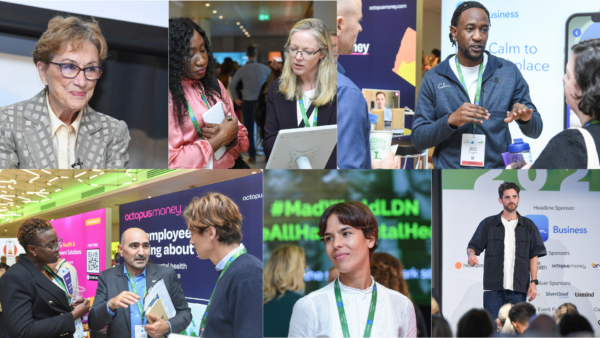

We'll Be Sharing
Latest Make A Difference News

Professionals who have a remit that touches on Workplace Culture and/or Employee Health and Wellbeing often know instinctively doing this work that employees who are engaged in their jobs are more productive and healthier. However, for many, it can still be challenging to prove the business case with reliable, convincing data.
But – in this episode which builds on our last episode on the New Era of Engagement with Euromonitor’s Adeife Onwuzulike – you’ll hear concrete, cross-industry evidence which proves the link between engagement and not only productivity but talent attraction, talent retention, reduced turnover, profitability and shareholder returns.
Jo Moffatt, who is Advisory Board member for not-for-profit Engage For Success shares the findings of recent research which highlights the impact of Health and Wellbeing initiatives, and the benefits of listening to and valuing employees.
But the big question is – how do you engage your employees to reap these benefits?
Jo shares her 4 most important actions, based on extensive research, to achieve this. She also offers lots of practical tips along the way, many of which don’t cost anything except effort and consistency.
You can listen to wherever you get your podcasts, such as Spotify, Apple and Amazon
Timeline of podcast:
00:00 Introduction to the Leaders Podcast
00:35 This Week’s Challenge: Engaging a Disengaged Team
01:06 Guest Introduction: Joe Moffitt from Engage for Success
01:39 Defining Employee Engagement
02:43 Engage for Success: UK Employee Engagement Survey
05:02 Key Findings from the Survey
11:23 The Four Enablers of Engagement
19:00 Survey Fatigue vs. Inaction Fatigue
20:35 Engaging Senior Management
25:32 Conclusion and Final Thoughts
Listen on Spotify, Apple or wherever you get your podcasts. And why not share it with a colleague, or c-suite member, who would benefit from hearing the conversation?
You might also like:

New Leaders Podcast: engaging employees so they go the extra mile without burning out
At Make a Difference Media, we believe organisational success, workplace culture and employee health and wellbeing are inseparable. Our goal is to ensure employers of all types and sizes have the insight and inspiration they need to make a real impact. As part of this – and recognising that our audience likes to access content in different ways – in September this year, our Editor, Suzy Bashford, launched the Make a Difference Leaders’ Podcast.
Each episode features practical, relatable conversations with leaders who share how they’ve tackled real-life challenges related to workplace culture, employee health and wellbeing.
If you haven’t tuned in yet, these podcasts are well worth making time for. Suzy has a real talent for helping guests relax, open up, and explore honestly what works – and what doesn’t.
Here are the seven episodes that resonated most strongly with our audience in 2025.
1) Budgets are tight, how do I choose the best health intervention with the biggest impact on employees?
The top spot goes to Suzy’s conversation with Dr Lia Ali, Digital Health Innovation Strategist, exploring how to choose wellbeing solutions that add real value.
Ali was chosen as an interviewee because of her immense knowledge of being able to pinpoint what actually works – and what WILL work – based on the evidence. She’s faced this question numerous times, and talks us through how she tackled it.
2) Leaders spill their biggest Culture, Health & Wellbeing problems
Next up is me! I loved having this conversation with Suzy.
As Co-founder and Global Head of Content of Make A Difference, I get to hear leaders from all different sectors and industries open up about their biggest challenges. In this podcast episode I share the struggles that I hear most from leaders and what I think the industry can do to make the most impact going forward – including the D word…
3) How do I get people with INFLUENCE behind the Health and Wellbeing agenda?
Third on the list of most-listened-to podcasts is Dr Sabrina Robinson, Chartered Psychologist and Wellbeing Lead at Essex County Council.
In this episode Sabrina talks us through what to do if you need more influential people, especially those not working in Wellbeing or those who aren’t personally invested to drive the workplace culture, employee health and wellbeing agenda.
4) Why are young employees such SNOWFLAKES?!
Fourth on the list is Alex Smith, Global Lead for Lifestyle, Leisure, and Wellbeing at Unidays.
Alex shares his unique and at-the-coalface insight into the mindset of young people today. He delves into the importance of self-awareness and understanding the different life experiences that shape team members’ perspectives. And highlights practical strategies for fostering a supportive and inclusive environment.
5) My multigenerational team isn’t gelling!
Picking up the challenges of the multigenerational workforce is Patrick Dunne OBE.
We know the theory: difference leads to innovation and, ultimately, profitability. But, in practice, working in multigenerational teams can be really challenging and lead to a lot of tension. Patrick Dunne OBE has seen this situation numerous times in his vast experience of business and boards – he’s also just co-written a book called ‘Five generations at work; how we win together for good’.
This conversation covers everything from a maximising mindset, empathic leadership, dealing with conflict, ‘microwaved’ relationships and even dad dancing. It’s peppered with practical tips and real-life solutions he’s seen work.
6) How do we balance profits and caring for people, when the proverbial poop hits the FAN?!
Next on the list are Suzy’s two guests from the legal industry – a sector known for its well-paid but high-pressure work environments – where many thrive, but the risk of burnout is also high.
One is Sam Jardine, Partner at Fieldfisher LLP and LawCare Chamption, and the other is Elizabeth Rimmer, CEO of LawCare, which promotes and supports good mental health in the legal industry across the UK and has just launched its latest report, Life in Law 2025.
This is a fascinating wide ranging conversation, with loads of practical ideas and tips, as well as a bit of philosophy, AI predictions and even poetry.
7) A BIG drop in employee engagement in Health & Wellbeing?
Wrapping up our top seven most-listened-to podcasts of 2025 is Suzy’s conversation with Stella Gavinho, Group Head of Wellbeing at Entain.
Stella was chosen as one of the launch interviewees for her honesty and warmth, as well as the energy and resilience she applies to problem solving. In this episode she talks us through dealing with a significant drop in employee engagement in employee health and wellbeing, with lots of practical and strategic insight.
You might also like:
You can find all the episodes of Suzy’s Leaders’ Podcast here:

The 7 most-listened-to Leaders’ Podcasts from Make a Difference Media
As we enter a new year, the world of work is also entering a new era, shaped by ongoing global, political, cultural and legislative shifts. For HR and DEI leaders, this means remaining agile enough to flex to an ever-changing workplace.
Those who anticipate and effectively adapt to change will reap the rewards. However, organisations that fail to evolve with the times will simply be left behind.
Looking ahead, FAIRER Consulting sees several trends that are expected to shape fairness and inclusion at work in 2026 and beyond.
1. Organisations that sideline DEI will be left behind
A CIPD report found that 21% of leaders are not committed to having a diverse workforce, and 17% are not committed to having an inclusive workforce. These are the organisations that will remain stagnant.
Businesses that commit to DEI strategies are better equipped to navigate legal, reputational and social risks. As a result, fairness becomes part of a long-term culture-change strategy that strengthens the employee value proposition (EVP), rather than existing as a tick-box exercise.
As MD of FAIRER Dan Robertson explains: “Too often DEI is positioned as a ‘corrective measure’. The psychology of this is that something ‘bad’ needs to be fixed, and the DEI army of social warriors are here to help. This creates an ‘us’ and ‘them’ negative dynamic from the start.”
To avoid this, companies need to move away from tick-box DEI training sessions that employees are mandated to attend when something goes wrong. Leaders must instead thread fairness throughout the organisational fabric, embedding inclusion across all parts of the business and all stages of the employee lifecycle.
2. Businesses will see enforced legal and reporting procedures
The UK Government’s 2023 ‘Inclusion at Work Panel’ highlighted the need for more evidence-based tools, more support for employers to drive fairness, and called for organisations to enrol in the Inclusion Confident Scheme. In fact, the UK Government is currently preparing to mandate ethnicity and disability pay gap reporting to drive visibility and help reduce disparities.
Other recent legislative changes, such as the UK Supreme Court ruling on the definition of Sex in April 2025, the Worker Protection (Amendment to Equality Act 2010) Act’s strengthening of the duties on employers to prevent sexual harassment in October 2024, and upcoming changes expected as a result of the Employment Rights Bill are all adding layers of additional reporting, and new requirements and responsibilities for organisations.
Legal mandates provide a starting framework for organisations. They help define expected behaviour, provide better protection and drive accountability. As a result, fairness becomes a shared goal and expectation across the board.
However, many businesses are getting ahead of these changes and implementing pay gap reporting before it becomes mandatory. By having visibility of the potential gaps sooner, they have a head start on introducing strategies to close them.
When it comes to DEI, only following the legal mandates is the bare minimum.
Those truly committed – and those who have the strongest EVPs, candidate attraction and retention – go beyond the minimum.
3. Fairness must be normalised and clearly defined
Is fairness truly universal? Fairness is often misunderstood as giving ‘special treatment’ when, in fact, it is about levelling the playing field. Furthermore, what is considered ‘fair’ is often subjective and shaped by local norms, values, and context, especially within global organisations.
To add, legislation varies by location, so what happens when a company’s or individual’s sense of fairness conflicts with local customs or expectations?
For example, a UK subsidiary may align with parent company values but must also comply with the Equality Act 2010. UK companies are mandated to disclose diversity data – such as gender and ethnicity – whereas other international subsidiaries might not have these mandates. In fact, countries such as France, Austria, and Belgium forbid the collection of race and ethnicity data.
Political backlash against DEI adds another layer of complexity. Influenced by figures like Donald Trump and other prominent U.S. business moguls, some companies are rebranding DEI using less politicised language. Terms such as ‘culture’, ‘wellbeing’, ‘inclusive leadership’, or ‘belonging’ are increasingly used to mirror local sentiment and avoid controversy.
Ultimately, companies must decide which values are most important to them. If fairness remains a core value, organisations must find ways to stay aligned with their ‘north star’.
For many, this means relabelling DEI in a way that resonates across different cultural and political contexts. While it’s not always possible to have a universal approach to fairness, businesses can still act with honesty, explain decisions, tailor their approaches to local markets, and ensure that company-wide and global initiatives are executed with respect.
4. Organisations need to redefine what authenticity at work means
While organisations often encourage employees to ‘bring their authentic selves to work’, it is not always clear what ‘authenticity’ means in practice, presenting a challenge when employees behave unfavourably.
If employees choose to only show a certain part of themselves at work, is that because they are being inauthentic or because they don’t feel comfortable enough to show more?
Promoting psychological safety is key to encouraging employees to be their authentic selves. Leaders must model by example, showing vulnerability by sharing their own experiences, demonstrating empathy and creating safe and judgement-free spaces for open dialogue.
While promoting authenticity at work is important, it should never become an excuse for disrespectful behaviour. Managers should set clear expectations around behaviour and professionalism, ensuring that psychological safety does not mean a lack of boundaries.
The key remains in striking a balance where employees feel safe to express themselves within a context of mutual respect – where individuality is celebrated, but disruptive actions are appropriately addressed.
5. We need to close the inclusive leadership skills gap
A report from the Chartered Management Institute (CMI) found that 82% of managers ‘become managers by accident’, having received no formal management or leadership training. Research from the Centre for Economic Performance at the London School of Economics shows that quality of management can affect performance by up to 30%.
Additionally, the CMI estimates that poor management costs UK businesses a staggering £84 billion every year. Supporting the case, Harvard Business Review found that inclusive organisations are 73% more likely to drive innovation, up to 50% more likely to make better decisions, and up to 36% more likely to outperform financially.
Closing this skills gap means developing core capabilities such as empathy, psychological safety and conscious inclusion – qualities that are critical for navigating complex work environments. Without these skills, organisations risk losing trust, talent and diverse employees.
Our inclusive leadership training is designed to empower leaders with the tools and confidence to model these qualities, and provide safe spaces to ensure every voice is heard and respected.
6. Organisations need to be more prepared with their responses to society
In a survey of 4,000 UK and US employees, one-third of respondents quit their jobs because their employers made insufficient efforts to address environmental or societal challenges. Furthermore, a HiBoB survey found that 43% of respondents would reject a job offer if the company’s political stance opposed their own.
Company values are important to employees, with 92% of people believing businesses should speak up on societal issues.
Despite this belief, 80% of respondents to Race Equality Matters’ recent poll said their organisations remained silent about the recent anti-immigration protests. Corporate silence is a choice and can suggest complicity. Leaders must speak up and let the organisation’s stance be known. If businesses can’t speak out verbally, they should remember that actions speak volumes too.
Reflecting on these changing expectations, FAIRER’s Barry Boffy explains: “Employees increasingly want to know that the organisation they work for has a moral voice and is committed to tackling social inequalities and injustices. Perpetuating a need to maintain ‘organisational neutrality’ is no longer an acceptable position for an employer to take, even in the face of increasingly complex, polarising or divisive beliefs, values or events on the world stage.”
Barry goes on to say, “Leaders rightly worry about being asked to take a stance on what can sometimes be contentious or deeply divisive issues, and this can often mean a protracted period of time where information is gathered, legal and compliance teams are engaged and debate takes place.
“However, that can sometimes result in days, weeks or even months of silence whilst the organisation’s official response is carefully crafted. This period of silence is much more likely to be interpreted by employees as a lack of interest or that the organisation is ignorant to the issue or even an uncaring employer. As such, it’s vital that leaders acknowledge inequalities and injustices wherever they exist, even if they may not have an immediate answer or solution to the problem.”
Stay ahead of the curve – your next steps for 2026
As organisations adapt to an evolving workplace, fairness and inclusion must become the foundations of the business strategy. The businesses that succeed will be those that thread DEI into everyday culture, plan for upcoming legislation, invest in inclusive leadership skills, and respond appropriately to societal issues.
Key takeaways:
- DEI must not be sidelined. Organisations that treat DEI as a tick-box exercise risk getting left behind.
- Legal and reporting obligations are becoming more regulated. Organisations that remain proactive will stay ahead of the curve.
- Fairness needs to be clearly defined, especially across global organisations.
- Authenticity at work should be encouraged, but it requires psychological safety, clear boundaries and leadership role-modelling.
- The inclusive leadership skills gap needs to be closed. Managers require formal training to model conscious inclusion, empathy and psychologically safe leadership behaviours.
- Employees expect organisations to take a stance on socio-political issues. Silence is complicity – if you can’t use your words, use your actions.
Turn the above insights into meaningful action and make 2026 a year full of intentional and positive change.
Register for our webinar, Key DEI trends to watch in 2026, to take a further look into what’s set to shape the future of inclusion. Learn how to create a cultural-change DEI strategy with long-term goals and actions tailored to your organisation.
Alternatively, upskill your leaders with inclusive leadership training, designed to close the skills gap and promote an inclusive culture from the top down.
Not sure where to begin? Get in touch for a complimentary one-to-one consultation and we’ll help you map a clear path forward.
About the author:
Barry Boffy is an award-winning inclusion, equity and diversity thought leader with a history of working in the policing and criminal justice sector, winning the ‘Public Sector Champion Award’ at the Inclusive Companies Awards in 2018. He is a passionate advocate for victim rights and for a kinder, fairer and more inclusive world for all.
You might also like:

6 DEI trends to watch in 2026
When we asked Health and Wellbeing Leaders about their priorities for 2026, the answers centred on prevention, data and early intervention. While there is some overlap, the lens is quite different for Chief People Officers.
CPOs focus on the system. Whereas Health and Wellbeing Leaders tended to ask how to protect health, CPOs tended to ask: what kind of workplace are we actually designing?
Across sectors, one word came up again and again: culture. But CPOs are no longer talking about culture as an abstract aspiration. In 2026, it’s being treated as a design project, a performance lever and a leadership accountability.
Here are the key themes shaping their thinking.
1. Culture as the operating system
Almost every CPO we interviewed cited “culture” as their defining priority for 2026.
Bola Ogundeji, former CPO at Moorfields Eye Hospital and London Legacy Development Corporation, describes a deliberate shift “from responding to individual strain toward designing a system in which people can thrive.”
Tracey Lowe Sheppard, Head of People at Swim England, says that “embedding values” will be the foundation of the year ahead, with line manager training, performance reviews, recruitment and recognition all being aligned so that culture becomes “second nature, not just buzzwords.”
Others talk about using behaviour-based KPIs to shift culture meaning line managers are assessed on not only what they deliver, but how they deliver it.
This echoes Sir Charlie Mayfield’s Keep Britain Working review, which identifies toxic fear cultures as a major barrier to workforce health and economic participation. But where the report names the problem, CPOs are now focused on the infrastructure needed to fix it.
2. Leaders as the primary drivers of change
Leadership is the interface of the cultural operating system. Without confident, capable managers, culture change buffers.
One CPO explains why leadership capability is a priority:
“We recognise that wellbeing is an evolving area and we don’t just expect our leaders to know what to do in this space.”
CPOs agree that leaders need practical, often scenario-based capability that builds confidence in difficult conversations. Their concern is not just spotting risk, but whether leaders have the authority, skill and psychological literacy to act on it.
As Ogundeji puts it, leaders are no longer just people managers. They are becoming “health-conscious, change-ready enablers of performance, who need supported to “use technology intelligently and lead with agility through constant change”.
3. Reframing ‘Health and Wellbeing’ as ‘Performance’ – not a trade-off
CPOs are also deliberately reframing Health and Wellbeing through the language of high performance.
Several describe moving away from presenting wellbeing as something separate from business outcomes. Some even mention dropping the language entirely — reflecting the debate highlighted in our previous Health & Wellbeing Leaders piece.
But CPOs agree that leaders need to be supported explicitly to understand that looking after people is not at odds with delivering results — it creates better results.
One CPO explains:
“Our leadership training now focuses on understanding the link between wellbeing and business impact. If you only talk about wellbeing, leaders can assume you don’t understand the pressure they’re under to deliver. So we focus on how leader behaviour impacts wellbeing and how actions that support wellbeing also protect performance.”
4. Designing work that works: from organisational risk to personalised support
This was one of the most strategically important shifts we heard.
Rather than asking individuals to become more resilient, CPOs are asking what is structurally harming wellbeing. Workload, utilisation targets, line management quality, fairness, job design and role clarity are now being treated as organisational health and safety hazards, not personal weaknesses.
Ogundeji says:
“In a climate of high external pressures, employers are working to provide clarity, belonging and stability so people can perform with confidence and feel respected and valued.”
Many CPOs are now applying health and safety thinking to mental health, identifying “risks and hazards” in exactly the same way organisations do for physical safety.
At the same time, support is becoming more personalised. CPOs describe moving away from one-size-fits-all wellbeing programmes towards bespoke, inclusive approaches that reflect different roles, health needs, cultures and geographies.
5. Elevating ‘soft’ skills and human connection
Fabiola Williams, CPO, Brunswick Group, caveats this priority by saying “of course in the wellbeing space we’re clearly doing a lot of practical things, and working on policies that work for our people” but what she believes helps policy work and behaviour change happen, are the deeper relational skills:
“Calling them ‘soft’ skills reduces their importance. They are the hardest skills to get right and they are at the heart of collaboration, team work and psychological safety. And all these things are directly linked to wellbeing.”
Helen Matthews, former CPO at Weber Shandwick, speaks about the need for “intentional connection” at work, urging CPOs to ask:
“How do we create meaningful connection and community for personal and professional growth?”
Collaboration is also a key theme in the Health & Wellbeing Leaders piece. But CPOs see it more as a human capability that must be developed deliberately.
7. Mental health and financial wellbeing: persistent pressure points
Despite years of investment, mental health remains a top concern.
As Tracy Leghorn, Chief Business Services Officer at SUEZ, puts it:
“Mental health is a priority. Despite doing a lot in this space over the last five years, it’s still an area our people continually say they need support with.”
CPOs speak openly about the need to strengthen crisis support, suicide awareness and everyday mental-health literacy. Financial wellbeing is now firmly part of this picture too. With sustained cost-of-living pressure, SUEZ has introduced auto-enrolment savings in the same way pensions once transformed retirement behaviour.
This mirrors what Health & Wellbeing Leaders told us: mental and financial strain remain overlapping drivers of employee stress.
8. AI, ethics and the future of human work
AI surfaces as both an opportunity and a risk.
On one hand, some experts like Catherine Muirden, a seasoned CPO, and now Chair at the National Galleries of Scotland, see AI as a way to remove “the markers of a bad working environment” — especially repetitive, dehumanising tasks — freeing people for more purposeful work and greater autonomy.
On the other, she warns about creating negative cultures through surveillance, ethical drift and the danger of “infantilising” workers through over-tracking their behaviour in the name of productivity.
Matthews believes a core CPO priority should be:
“Encouraging clarity about where AI fits within the organisation and taking people on that journey through co-creation, leadership accountability and open communication.”
You might also like:

8 Chief People Officer priorities for 2026 – and why
Despite progress, there remains an understanding gap when it comes to menopause which is still treated as a personal health matter rather than a workplace issue in many small and micro-businesses. But this comes at a significant cost for women and the businesses they work for.
Around three quarters of women experience menopause symptoms which go beyond physical changes and can include anxiety, low mood, sleep disruption, brain fog and loss of confidence, which can have a significant impact on mental health and day-to-day functioning at work. The CIPD’s 2023 Menopause at Work report found that 67% of women aged 40–60 in employment who have experienced menopausal symptoms say these have had a mostly negative effect on them at work.
This obviously has negative consequences for retention and this is backed up by data. Research by The Fawcett Society found that 26% of women who have been employed during the menopause had taken time off work due to their symptoms. Similar research by Simply Business found that 38% of women reduced their working hours, whilst 10% left employment altogether. For smaller teams, losing highly-skilled women from specialised roles can be disruptive and expensive.
Despite this evidence, many companies still see menopause support as something that is reserved to the HR departments of larger organisations. But the majority of British businesses are SMEs with no HR support. The good news is that supporting mental health through menopause does not have to be expensive or complicated.
Here are five practical ways SMEs and micro-businesses can begin to support mental health through menopause.
1. Build a culture where menopause can be talked about safely
The way that employees are made to feel at work, the tone of informal conversations, and the behaviour of the leadership teams dictates how safe people feel to talk about their wellbeing at work. The CIPD report found that many women experiencing menopause symptoms feel to embarrassed to talk openly about it at work, often due to fear of judgement, or being seen as less capable.
According to The Fawcett Society, many women end up reducing their hours or leaving work during menopause due to the lack of understanding and resulting stigma. For small teams, this can affect morale, continuity and engagement.
Creating a supportive culture is not about creating complicated policies, but rather making sure that all team members know that conversations about menopause and mental health are welcomed.
2. Treat menopause-related mental health symptoms as legitimate workplace needs
Menopause symptoms can affect a woman’s confidence, concentration, emotional wellbeing and general ability to function at work. Symptoms such as anxiety, low mood, sleep
disruption and cognitive fatigue can be harder to spot than physical symptoms and can easily be overlooked. It is important that we recognise menopause as a legitimate workplace issue and don’t mistake it for poor performance or a lack of engagement.
Stigma and poor understanding around menopause can increase the stress and anxiety that women feel at this time, particularly if they don’t feel safe enough to ask for support at work. But mental health issues related to menopause can quickly escalate into sick leave, disengagement, and eventually the decision to reduce hours or leave work entirely.
It is vital that SMEs respond to menopause-related issues earlier and with compassion to protect women’s wellbeing and reduce potential performance issues.
3. Use flexibility as a mental health support tool, not a special favour
In small and micro-businesses, flexible working arrangements can be a great tool when used intentionally. Menopause symptoms, such as disrupted sleep, emotional volatility and cognitive fatigue can fluctuate from day to day, so fixed schedules, lack of autonomy and rigid expectations often create more stress for women experiencing these symptoms and can increase the risk of burnout. Flexibility, on the other hand, enables women to better manage their symptoms before the situation escalates into absence.
Flexibility can be as simple as adjusting start and finish times to account for disrupted sleep, allowing women to work from home where possible or temporarily adjusting workloads when symptoms are particularly bad.
It is important that this flexibility is framed as a reasonable workplace adjustment, not special treatment. If women feel they need to apologise for or justify the need for flexibility, this leads to more stress and anxiety which undermines the support being offered.
4. Accept that one size does not fit all, especially for neurodivergent women
Menopause is not the same for all women and the support on offer needs to reflect their differing experiences. Symptoms can vary in type, intensity and duration and there are factors that can make menopause symptoms more challenging for some women.
Research from The Women’s Organisation highlights how menopause can make existing neurodivergent traits more challenging for menopausal women. Their report found that 61% of women with ADHD said it had the greatest impact on their daily lives between the ages of 40 and 59. During this time, women may experience more difficulties with concentration, emotional regulation, sensory sensitivity, and executive functioning. If we try to standardise our assumptions about what menopause “should” look like, we risk overlooking the experiences of those affected.
For small businesses, individualised support can be reasonably easy to provide. Smaller teams are more agile so can adapt communication styles, workloads and environments based on direct feedback. When we can work with women to provide the support they need rather than basing our support on a standardised checklist, we have a much better chance of improving mental wellbeing and performance.
5. Equip managers and owners with the confidence to start the conversation
Many small business owners and managers lack the confidence to provide the necessary menopause support that women need. They often worry about saying the wrong thing, overstepping boundaries, or causing offence and this can lead them to avoid conversations about menopause and mental wellbeing.
The CIPD’s Menopause at Work report highlights that managers often don’t feel equipped to have conversations about menopause and this can delay support and leave employees feeling overlooked, anxious and stressed.
It is a misconception that specialist clinical knowledge is required to provide the needed support. In reality, women aren’t expecting a diagnosis from their manager or employer. Rather they need basic guidance on menopause and its mental health impacts, and respectful conversations focused on how menopause is changing their needs at work. Employers should focus on listening and signposting to further support where necessary.
When managers can start these conversations early, they can prevent menopause-related issues from escalating into absence, disengagement, or resignation.
For SMEs and micro-businesses, supporting mental health through menopause does not require perfect policies or medical expertise. Menopause simply needs to be recognised as a common life transition that affects mental wellbeing, performance, and retention. Employers should respond with compassion, flexibility, and understanding. It is when menopause is ignored or misunderstood that businesses risk losing experienced, capable women at a critical point in their careers.
About the authors
Victoria Brookbank and Haley White are the co-founders of Menominds, a fully funded UK-based training initiative and workshop programme that supports self-employed women and those working in small and micro-businesses who are dealing with the mental health challenges linked to perimenopause and menopause. Together, they bring expertise in psychology, workplace wellbeing, and menopause awareness, with a shared focus on helping women feel understood, supported, and able to thrive at work and beyond. They support individuals and organisations to better understand the mental health impacts of menopause and to create more compassionate, inclusive approaches to wellbeing in the workplace. Find out more at https://www.menominds.co.uk/
You might also like:

5 steps SMEs can take to support mental health in menopause
Across the past year, our articles on www.makeadifference.media have reflected the topics shaping today’s workplace – and a growing recognition that employee health and sustainable performance are inseparable.
From the evolving challenges of hybrid working and neuroinclusion, to financial wellbeing, alternative career paths, the role of managers in creating psychologically safe cultures, and what employers can do to tackle the obesity crisis. These issues have clearly struck a chord with our audience.
Which articles have you found most inspiring and useful – and what topics would you like us to explore next? Share your ideas in our survey (and you could win one of two £100 John Lewis vouchers).
Here are the 10 articles that resonated most with readers in 2025.

1. The 2025 Challenges that need to be on your radar
This forward-looking piece offered clarity on the challenges likely to shape the wellbeing agenda in 2025.
“Organisational wellbeing looks at changing the way we set ourselves up to work, and this is not what a lot of C-Suite want to accept.”
Make A Difference editor Suzy Bashford spoke to leading health and wellbeing experts for this article, which explored issues influencing workplace wellbeing and highlighted why organisations needed to be proactive, rather than reactive, in the year ahead.

2. What are Health & Wellbeing Leads prioritising in 2025?
This article brought together insights from leading industry professionals, capturing the priorities shaping wellbeing strategies for the year ahead.
“Rather than waiting for problems to arise…employers should proactively identify and mitigate risks.”
It showed how health and wellbeing leads were increasingly prioritising prevention and early intervention, alongside listening to employees and focusing on learning and measurement.

3. Case Study on future-proofing career paths: AtkinsRéalis
For this case study, we spoke to Jo Rigby, Senior Director, Global Lead Performance, Talent and Careers, Human Resources at engineering firm AtkinsRéalis. It struck a chord with readers interested in how career development can play a meaningful role in supporting long-term wellbeing.
“We’re freeing people from being defined by their jobs. Instead employees are seen as whole individuals.”
It demonstrated how reframing careers in this way can help reduce pressure, support long-term wellbeing and create working environments where people feel valued beyond their job title.

4. Supporting the health and wellbeing of non-desk-based workers
This article reflected growing interest in the health and wellbeing of non-desk-based workers, a group that continues to be underserved by many traditional workplace wellbeing strategies.
It highlighted the unique challenges faced by employees who are not office-based, and explained why organisations need to think differently about access, communication and support if wellbeing initiatives are to be truly inclusive.

5. Neuro-inclusive workplaces: Creating spaces where everyone thrives
Neuroinclusion was a hot topic this year, and this article resonated with those looking to move beyond individual adjustments and think more holistically about how work is designed.
“For organisations to thrive, they must embrace inclusivity at every level, and neuro-inclusive design is central to this transformation.”
It explored why neuroinclusion should be seen as a core element of thoughtful workplace design, which benefits not only neurodivergent employees, but also the wider workforce.

6. Why managers should listen
The role managers play in shaping workplace culture and day-to-day employee experience also came into focus this year.
“Listening goes beyond individual interactions. It contributes to creating a workplace culture of trust, collaboration, and psychological safety.”
Written by Carole Spiers, Chair at ISMA UK, it reinforced why listening should be seen as a core leadership behaviour rather than a soft skill, and how feeling heard can directly influence wellbeing, engagement and team dynamics.

7. How three employers are addressing the challenges of hybrid working
As hybrid working became more established, organisations began to confront the day-to-day realities of how it affects employee wellbeing.
67% of workers who felt isolated in their remote work environment reported higher stress levels and decreased job satisfaction.
This article looked at how three employers are responding to these challenges in practice, focusing on connection, communication and fairness to make sure hybrid working supports, rather than undermines, wellbeing.

8. Resilience is like Marmite: are you a lover or a hater?
Debate around resilience continued to divide opinion in 2025, particularly when it comes to how responsibility is framed at work.
Resilience has largely got to this point, where “we’re praising individuals for sucking it up, being ‘thick skinned’ and being brave about things being a bit rubbish”.
Pulling in varied experiences and opinions, the article questioned whether resilience has become a convenient catch-all, and explored the risk of placing too much responsibility on individuals instead of addressing the underlying causes of pressure at work.

9. First Bus and Money First Aid strengthen partnership to support employee financial wellbeing
Financial wellbeing continued to rise up the agenda in 2025, as the cost-of-living crisis remained a significant source of pressure for many employees.
57% name finances as the top cause of stress in their lives.
This article highlighted how partnerships like those between First Bus and Money First Aid can play a practical role in supporting employees, showing how targeted financial education and guidance can help reduce stress and improve overall wellbeing.

10. Why employers need to take action on the obesity crisis
Broader health challenges affecting the workforce also came into sharper focus in 2025, raising questions about what role – if any – employers should play.
“It’s becoming clear that the economy is more at risk from an obese, unhealthy population than from conflicting with food companies.”
In this article, Make A Difference editor Suzy Bashford spoke to obesity policy specialist Dr Dolly van Tulleken, about why employers need to take a more proactive stance on obesity and health, arguing that inaction carries long-term risks not just for individuals, but for organisations and the wider economy.
A huge thank you to all our readers, and to everyone who contributed to these stories and helped us continue the workplace wellbeing conversation.
Which articles did you find most useful or inspiring this year? And what topics would you like us to cover in 2026? Send your ideas to claire@makeadifference.media or suzy@makeadifference.media.

The 10 most-read Make A Difference articles of 2025
New research from GRiD, the industry body for the group risk sector, shows that 32% of employers do not measure the impact of sickness absence – despite ongoing national concern about productivity and rising levels of ill health, as highlighted in Sir Charlie Mayfield’s Keep Britain Working review.
The findings mark a significant shift from 2024, when the proportion of employers tracking absence reached a six-year high of 69%. In 2025, that figure has dropped to 61%, while the percentage not measuring absence has risen from 27% to 32%.
Accurate absence data is crucial for employers seeking to understand and address both absenteeism and its often-overlooked counterpart, presenteeism. Without visibility, organisations may struggle to identify the scale of the problem or choose effective interventions.
“It’s vital that employers record absence and have a good understanding of the impact to their business,” said Katharine Moxham, spokesperson for GRiD. “Those that do are in a much better position to know what support to put in place, and can then measure the return on investment of mitigating absence and expediting returns to work.”
How employers measure absence
Among employers who do track the impact of sickness absence, the most common method is calculating the cost of lost time (48%). Other approaches include:
- Measuring lost productivity (45%)
- Calculating the cost of sick pay provision (40%)
- Assessing indirect costs such as management time and colleagues covering work (39%)
- Tracking direct costs like agency fees or temporary staff (34%)
The role of employer support and early intervention
GRiD emphasises that employee benefits – particularly group risk products such as life assurance, income protection, and critical illness cover – play a vital role in supporting staff through health and personal challenges. Early intervention is especially important, as the chances of a successful return to work decrease the longer an employee is absent.
“Unplanned absences can disrupt workflow, reduce efficiency, and increase operational strain,” said Moxham. “Providing proactive support helps employees stay in work wherever possible and ensures a smooth, timely return when absence does occur.”
How do you track absence?
One reason why some employers may find it hard to measure the impact of absence is that they are struggling to track the reasons for absence in the first place.
This is a list of the
Most common sickness absence categories used by employers:
- Musculoskeletal disorders (e.g. back pain, neck and shoulder issues, joint problems, repetitive strain injury)
- Minor illnesses (e.g. colds, flu, headaches, minor infections)
- Mental health conditions (e.g. stress, anxiety, depression, burnout)
- Respiratory conditions (e.g. chest infections, asthma, COVID-19)
- Gastrointestinal issues (e.g. stomach bugs, gastroenteritis, digestive disorders)
- Injuries and accidents (e.g. sprains, fractures, falls, sports injuries)
- Chronic or long-term medical conditions (e.g. diabetes, heart disease, cancer treatment, autoimmune conditions)
- Surgery and medical procedures (including post-operative recovery)
- Pregnancy-related illness (excluding maternity leave)
- Work-related stress or pressure
- Other or unspecified reasons
I’d love to know how you approach this though. Please feel to add your thoughts to our LinkedIn chat here.
You might also like:

A third of employers still not measuring the impact of sickness absence, GRiD warns
In organisations where sick days and presenteeism are rising, and productivity is slipping, leaders are searching for ways to understand what’s really happening beneath the surface. One of the most effective tools? Employee listening circles and focus groups.
But how do you run these well? After posing this question on LinkedIn, a range of wellbeing, research and culture experts shared what truly makes these sessions work. Below is a distilled guide – nine punchy tips for running employee focus groups and listening circles that generate real insight and lead to meaningful action, followed by guidance for SMEs and when to bring in external facilitators.
A big thank you to everyone who contributed comments. You can see the full discussion on LinkedIn here.
1. Only listen if you’re genuinely prepared to act
Nothing destroys trust faster than asking employees for honesty and then doing nothing with it. As several contributors stressed: listening without action is worse than not listening at all. Before you begin, ensure leaders are ready for discomfort, committed to follow-through, and prepared to say, “Here’s what we can do – and here’s what we can’t.”
2. Use facilitators people trust
Whether internal or external, the facilitator must be someone employees feel safe with. In organisations with low trust, recent change, or sensitive topics, an external partner is often the right call. If using someone internal, choose the person employees already confide in – even if that’s not the obvious “official” choice.
3. Create psychological safety by designing the right groups
Group structure heavily influences how honest people feel they can be. Avoid mixed hierarchies unless the culture truly supports openness. Ensure representation across sites, roles, identities and working patterns. And when dealing with sensitive issues – health, identity or trauma – specialist facilitation is essential to manage disclosures safely.
4. Be clear on purpose – and keep it focused
Effective listening circles are intentional and streamlined. Beforehand, clarify what you’re trying to uncover and what decisions the insight will inform. Then design the conversation around a small number of powerful questions. Depth beats breadth.
5. Choose the right format – and facilitate creatively
Different groups need different formats: in-person sessions, online discussions, hybrid forums or asynchronous digital threads. Design for accessibility – especially for shift workers, frontline staff and neurodiverse colleagues. Use visuals, prompts or interactive tools like Mentimeter to spark conversation and avoid awkward silences.
6. Build trust through honesty, vulnerability and transparency
Trust is earned, not assumed. Be open about why you’re running the sessions, what you already know (and what you don’t), and how insights will be used. Small gestures of appreciation help, and regular updates – even “we can’t do this yet” – are essential to maintaining credibility.
7. Capture insights well – and consider AI for analysis
A great conversation is only useful if the insights are captured and synthesised properly. Decide upfront how notes will be taken, who will theme the feedback, and how priorities will be identified. AI can help you quickly recognise patterns in qualitative data – with human review ensuring nuance and accuracy.
8. Involve leaders thoughtfully – not performatively
Leaders can add weight to listening sessions, but only if their presence supports rather than suppresses honesty. A standout example shared involved leaders attending silently: present to absorb, not to defend or influence. This builds accountability without compromising openness.
9. Act fast on quick wins – and communicate visibly
Momentum matters. Identify two or three quick wins and implement them rapidly to show employees their input leads to change. Then map longer-term actions and keep people updated. Without visible progress, enthusiasm fades and scepticism grows.
Can SMEs use listening circles?
Listening circles can be just as powerful in small and medium sized enterprises (SMEs) as in larger organisations – sometimes even more so. But they do require thoughtful tailoring:
1. Smaller teams mean trust dynamics matter more
Because everyone knows each other, employees may feel especially exposed. Psychological safety and facilitator choice become even more critical.
2. Run smaller, more frequent circles
Holding several small sessions helps avoid making people feel singled out, while still gathering diverse perspectives.
3. External facilitation is often more helpful in SMEs
Employees may struggle to be fully honest with someone they work closely with every day. A neutral outsider can unlock more candid feedback.
4. Quick wins land faster and harder
In SMEs, small changes can dramatically shift culture because communication is direct and decision cycles are short.
5. Leaders must be visibly committed
In smaller organisations, leadership behaviour is highly visible – making follow-through even more important.
SMEs don’t need a lighter version of listening circles; they simply need one that respects closer-knit dynamics.
When does an external facilitator make sense?
Across all the perspectives shared, external facilitation is most valuable when:
1. Trust in HR or leadership is low
A neutral voice increases psychological safety and encourages honesty.
2. Topics are sensitive or high-risk
Issues like mental health, identity, trauma, cancer or menopause require skilled facilitation. As on contributor to the LinkedIn discussion noted, disclosures can happen – and must be handled professionally.
3. The organisation is in flux
During restructures, change programmes or uncertainty, people are more cautious. An external facilitator reduces fear of repercussions.
4. Specialist expertise is needed
Some conversations benefit from lived experience or technical understanding.
5. You want unfiltered insight
Employees often reveal more to a neutral outsider than someone embedded in the organisation.
6. The scale requires structured analysis
External partners can support design, facilitation and robust insight synthesis, often using advanced tools for qualitative analysis.
Bringing in external support isn’t a sign of weakness – it’s a sign of commitment to a process that values honesty and safety.
Listening that leads to action
Listening circles work when they are safe, purposeful and followed by action. They reveal what data alone can’t: the stories, barriers, emotions and solutions that shape employee wellbeing and productivity.
Done well, they create trust, clarity and momentum.
Done poorly, they damage credibility.
But when employees see that their insights lead to meaningful change, organisations become healthier, more resilient and more human places to work.
You might also like:

Nine essential tips for running employee focus groups that spark change around workplace culture, employee health and wellbeing
The greatest single opportunity to drive lasting employee engagement and maximise your wellbeing ROI in 2026 isn’t a complex new policy; it’s already on your calendar. It starts in January. For employers and HR leaders, the start of the year offers more than just a calendar reset; it presents a critical window of opportunity to drive significant, lasting employee engagement.
This is the essence of ‘The January Effect’: the annual surge in motivation that, when strategically supported, can transform a short-term perk into a core tool for talent retention and business resilience.
Latest research by leaders in the employee fitness benefits space, Hussle, investigates this phenomenon using new survey data to reveal what truly motivates employees to get active in the new year and what crucial barriers employers must remove to maximise their investment.
The new primary driver: mental wellbeing
The notion that January activity is simply about weight loss is outdated. New data shows that the pursuit of health is now deeply tied to mental resilience, a vital concern for a workforce facing a resilience crisis.
In Hussle’s latest survey of 3500+ respondents, they asked employees for their main reason for using the gym during the winter months, and the results were striking: the main motivator is ‘mental health,’ with 38% of all respondents citing this factor. This finding highlights that the New Year’s focus is driven by the desire for improved mental wellbeing, a priority that is now clearly higher in winter compared to previous research.
This is directly relevant to the current corporate landscape, where stress, depression, and anxiety account for the majority of days lost due to work-related ill health in the UK. By launching a high-value fitness benefit in January, employers are implementing a preventative tool at the precise moment employees are most receptive to engaging with their fitness goals, thereby maximising initial engagement, reinforcing a supportive culture, and reducing stress-related absenteeism.
Why January is the critical window for launch
The timing of your benefit launch is paramount to its long-term success. January is not just a market trend; it is a period of genuine, active commitment that aligns perfectly with both individual aspirations and the corporate calendar.
Our recent survey confirms this motivational peak: Overall, we are most motivated to go to the gym in January, with 22.6% of respondents indicating this as the most important month for them. This individual motivation is mirrored in industry data: according to UK Active, fitness venues across the UK are 28% busier in January than in December, and 10% busier than in the combined autumn months. This demonstrates that employees are actively seeking fitness solutions at this precise moment.
The January motivation surge is not a temporary change; it is the start of a long-term commitment for millions. If you can successfully capture and support this initial desire, the rewards are significant. Data from the fitness industry reveals that a full 50% of new members who join in January are still active 6 months later. This 50% long-term adoption rate is significant for any employee benefit and provides a strong foundation for year-round engagement. By launching in January, you align your investment with this natural employee commitment, ensuring your wellbeing budget delivers maximum ROI.
Internal Hussle data corroborates this spike: in January 2025, they saw a 46% increase in new monthly members compared to the overall 2024 monthly average. They also saw a 21% increase in gym visits when making the same comparison.
Aligning with the strategic HR calendar
Beyond individual motivation, January represents a strategic advantage for HR leaders. The start of the year typically signals the renewal of benefit programmes and the establishment of new corporate budgets and goals. This provides a clean slate for communication and adoption:
- Financial Alignment: Launching in January allows HR and Finance teams to integrate the benefit into the new fiscal year budget from the outset, streamlining planning and capital efficiency.
- Recruitment Advantage: January sees a significant “rebound” in recruitment activity. By offering a high-value wellbeing benefit when the market is competitive, you strengthen your total rewards offering and improve your ability to attract and retain top talent.
By launching a high-value fitness benefit in January, employers are implementing a powerful preventative tool at the time employees’ commitment and fitness goals are organically aligned, maximising initial engagement, reducing stress-related absenteeism, and reinforcing a supportive culture.

Understanding and removing the barriers
50% of new members who join a fitness venue in January are still active six months later. For these individuals, the desire for better health is genuine and long-lasting.
However, as you can see in the data from Sports Insight, many do not persevere with their newfound fitness goals. For the 50% of new joiners who drop off, the failure is often not a lack of interest but rigid benefit structures and financial barriers. The cost barrier is particularly acute during the New Year period, as we’ve also learned from Hussle’s recently conducted survey:
- Financial Squeeze: 27.4% of respondents say December clearly poses the most significant financial challenge, followed closely by January (16.35%).
- Targeted Support: This squeeze is particularly challenging for certain demographics; for instance, the 61+ demographic felt the January challenge most significantly, with 26% reporting this as their most financially restrictive month.
By offering a flexible, subsidised multi-venue benefit like Hussle, employers directly reduce the cost and rigidity obstacles that cause employees to quit. This intervention ensures that the mental and physical motivation employees feel in January is supported and sustained year-round.
The time to act is now
The data is clear: January is the moment when employees are most receptive to a high-impact wellbeing solution. You have a critical opportunity to capture this motivation, deliver a tangible benefit, and ultimately reduce costly absenteeism. Investing in workplace health initiatives has been shown to deliver a strong economic return.
Are you doing all you can to support your employees in getting more active?
Download the full report:
To access more survey results and a detailed strategy for leveraging ‘The January Effect’ to drive employee productivity and culture change, download the full ‘The January Effect’ report.
About the author:

As Hussle’s Head of Sales, Daisy James supports the ongoing growth of EGYM Hussle within the UK employee benefit space. She has an extensive background in corporate partnerships and business development and is incredibly passionate about helping employers to support their people through physical wellbeing initiatives. Outside of her day job, you can find her on long walks with her dog or at the gym!
You might also like:

